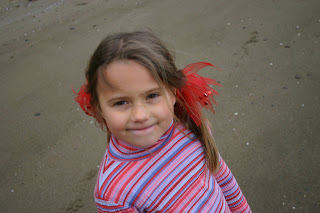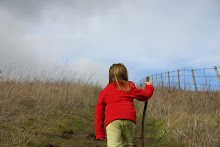Today we settled on a fundamental truth: children are like dogs, they need to be walked at least three times a day. Seriously. This is not meant to disrespect either dogs or children. It's probably true that all of us need to get out in the fresh air and exercise our body at least three times a day, it's just that dogs, who also require this outing for other reasons, get all the luck.
So, with this in mind and faced with a windy, rainy, cold day, we set off to explore new walks. We recently acquired awesome walking maps of all of the local counties and today we broke out the Marin county map. We've spent a lot of time in Marin and have hiked many of the more famous trails, but today we opted for bayside San Rafael, where we had never been before. And we were not disappointed.
Walk #1 McNear's Beach
It's pretty good in winter too. We had the beach to ourselves, except for one fellow picking up garbage. Strangely, there were dead jellyfish all over and this fellow told us that he'd heard it had something to do with the jellyfish getting carried by currents to this place where the bay water met the ocean water and they couldn't survive the resulting salinity. We tried to believe they weren't really dead, but were going to be carried back to life with the high tide.
It rained quite a bit, but walking along in the windy rain, breathing in the bay air was spectacular. Eliza, who was hideously cranky in the car on the way over, visibly loosened up as we walked and was positively pleasant by the time we were climbing back into the car.
Walk# 2: China Camp Village
At its peak in 1880, nearly 500 people lived here, catching and preparing shrimp for sale at local restaurants and for export to China. Soon after, a series of discriminatory laws were passed, beginning with the Exclusion Act of 1882 which forbade new immigrants from China and denied citizenship to Chinese immigrants already in the United States (this Act wasn't appealed for sixty years). Locally, laws began limiting the fishing season, banning the export of dried shrimp, forbidding traditional Chinese fishing techniques, restricting the size of the catch and generally limiting the ability for Chinese immigrants to continue to exercise their rights to earn a living.
At the same time, the local environment was being degraded. Houses were being built on fragile wetlands and the San Francisco and San Pedro Bays were feeling the burden of industrial pollution. All of this led to diminishing shrimp supplies. Between the racist policies and environmental degradation, the shrimping community continued to dwindle and eventually died out.
In 1977, China Camp opened as a State park and a descendent of one of the original fishing villages, Frank Quan, continued to operate the cafe and general store and share stories of the village's vibrant past. When we were there, the store was closed and it's unclear from dated Internet sites, whether it still operates in the summer (it looks like it does) or whether the Quans are still running it. In any case, we'll certainly be back to find out.
Walk #3: Las Gallinas Ponds and Salt Marsh












































